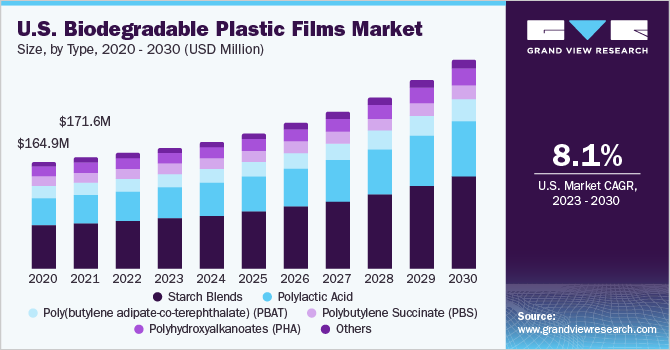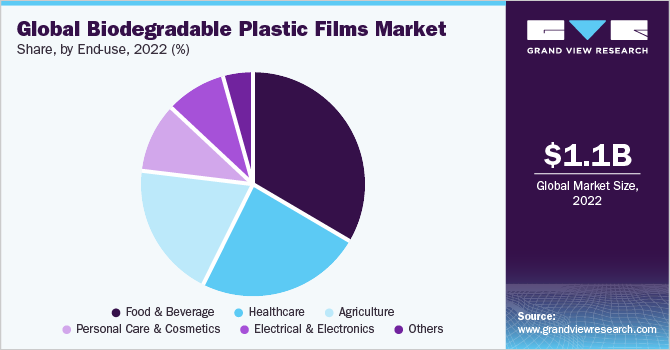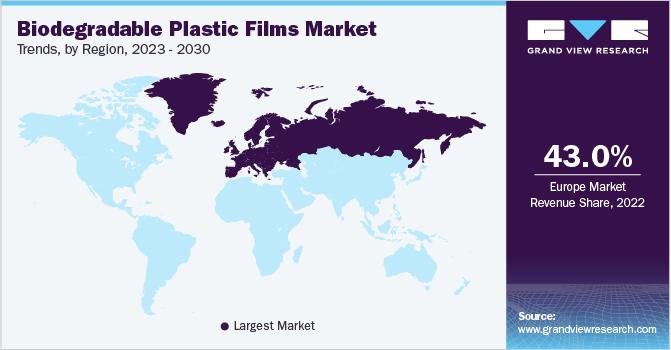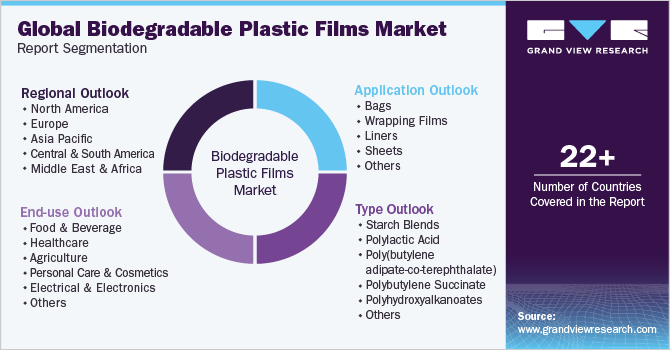- Home
- »
- Plastics, Polymers & Resins
- »
-
Biodegradable Plastic Films Market Size, Share Report, 2030GVR Report cover
![Biodegradable Plastic Films Market Size, Share & Trends Report]()
Biodegradable Plastic Films Market Size, Share & Trends Analysis Report By Type (Starch Blends, Polylactic Acid, Poly(butylene adipate-co-terephthalate), PBS, PHA), By Application, By End Use, By Region, And Segment Forecasts, 2023 - 2030
- Report ID: GVR-4-68040-116-5
- Number of Report Pages: 110
- Format: PDF, Horizon Databook
- Historical Range: 2018 - 2021
- Forecast Period: 2023 - 2030
- Industry: Bulk Chemicals
Report Overview
The global biodegradable plastic films market size was estimated at USD 1.10 billion in 2022 and is expected to grow at a compound annual growth rate (CAGR) of 7.64% from 2023 to 2030. Growing environmental awareness and rules demanding the reduction of plastic waste is expected to augment the demand for biodegradable plastic films over the forecast period. These films are gaining popularity as a more environmentally friendly alternative to traditional plastic films, which are not biodegradable and contribute to pollution. The market in the U.S. is predicted to expand due to the rise in environmental concerns, regulatory measures, customer demand, and technological improvements. Biodegradable plastic films are very effective accounting to its characteristic such as mechanical strength, gas barrier, and moisture absorption. These films help reduce the carbon footprint due to its high bio-content.

Technological advancement in plastic recycling facilities is expected to create demand for biodegradable plastic films over the forecast period. Growing demand for sustainable products with higher performance efficiency is anticipated to boost the demand for biodegradable plastic films based packaging solutions mainly in healthcare and food & beverage industries.
The favorable government regulations implemented in the country related to the production of biodegradable plastic films, along with the recycling initiatives, are projected to fuel the growth of the market in the U.S. over the forecast period. For instance, in June 2021, the Plastics Pact of the U.S. proposed a National Strategy to Achieve Circular Economy Goals by 2025. The approach, named "Roadmap to 2025," is backed by approximately 100 firms, NGOs, research organizations, start-ups, universities, and state and local governments from all sectors of the plastics packaging value chain.
The rising foreign investment policies in the country are boosting the installation of manufacturing plants across North America. Moreover, the rise in demand for green technology and increase in healthcare expenditures are expected to fuel the growth of biodegradable plastic films in the country.
Type Insights
The starch blends type dominated the type segment and accounted for the largest market share of over 41.0% in terms of revenue in 2022. These films are known as more environmentally friendly than traditional polymers due to their qualities, such as renewable and abundant resources. Furthermore, starch blends are considered effective biodegradable fillers due to their thermal stability and minimal interaction with the melt-flow properties of materials.
Polylactic acid is one of the major types of biodegradable plastic films industry. PLA-based films are a biodegradable and compostable alternative to typical plastics as they are produced from renewable resources such as maize starch and sugarcane. Concerns regarding plastic waste and environmental degradation are driving demand for more sustainable packaging and products.
Cellulose films is another type with a significant market penetration and growth rate. Cellulose films are compostable and biodegradable. It contains agricultural byproducts, water plants, grasses, and other plant compounds. Cellulose films are commonly used in the food & beverage industry for food packaging, which improves both durability and printability.
Application Insights
The bags sector dominated the application segment accounted for the largest market share based on revenue of 36.09% in 2022. Biodegradable films based bags are designed to break down naturally and reduce their environmental effect compared to conventional plastic bags. The growing awareness of plastic pollution and its adverse impact on ecosystems, wildlife, and oceans is the key driver of the growth of biodegradable bags.
Wrapping films application segment is growing with a significant CAGR owing to the growing demand for sustainable packaging solutions. Moreover, the use of biodegradable wrapping films aids to waste reduction by ensuring that packaging materials degrade organically, lessening the pressure on landfills and ecosystems.
In addition, biodegradable film-based liners are suited for various uses, including food waste collection and general waste management. Furthermore, they are utilized as liners to safeguard sensitive products such as electronics, delicate objects, or perishable goods.
End-Use Insights
The Food & Beverage industry dominated the end-use segment and accounted for the largest revenue share of over 33.50% in 2022. Biodegradable plastic films are commonly used in the food packaging industry for edible coating, wrapping films, egg trays, and food containers. The potential of biodegradable films to improve food quality, shelf life, safety, and usability is expected to propel the demand for biodegradable films in the food & beverage industry.

The use of biodegradable films is expected to grow in agriculture industry is expected to grow significantly over the forecast period. Due to their ecological benefits, agricultural biodegradable films are extensively utilized in specialized crop production systems. The usage of biodegradable films enhances soil quality, which promotes the worldwide biodegradable films market. It may be decomposed without damaging the environment by living creatures such as bacteria or fungi, with or without oxygen.
Furthermore, the healthcare industry continuously innovating to improve patient care and safety. Biodegradable films are utilized to provide protective barriers, sterile packing, and controlled discharge features for medical devices owing to their properties such as mechanical strength and barrier characteristics.
Regional Insights
Europe dominated the market and accounted for the largest regional share of over 43.0% in 2022. The region is experiencing growth in biodegradable films market owing to the increased awareness of environmental issues and governmental actions targeted at minimizing plastic waste.

Owing to presence of suitable infrastructure and technological advancement is expected to create demand for biodegradable plastic films in Germany. Stringent emission norms such as Single-Use Plastics Directive regulations, Germany will impose a Single-Use Plastics Levy on single-use plastics issued to the market beginning in 2024.
North America is predicted to grow at a significant rate over the forecast period owing to the rising awareness towards environment friendly product & solutions. Biodegradable plastic films offers recyclability and sustainability to the product. Furthermore, favorable government laws are encouraging global biodegradable plastic film players to establish manufacturing and distribution facilities in this region.
Key Companies & Market Share Insights
The global biodegradable plastic films market is a highly competitive market due to the presence of major industries across the region, as these companies are comparatively concentrated and fiercely competitive along with acquisitions, mergers, and collaborations. For Instance, In April 2023, BASF announced their plan to install an ecovio compounding capacity in Shanghai, China. The first compounds to be sold will be film grades for usage such as certified compostable retail and soil-biodegradable agricultural mulch films, organic garbage bags, and packaging. Some of the prominent players operating in the global biodegradable plastic films market include:
-
BASF SE
-
Cortec Corporation
-
Kingfa Sci. & Tech. Co., Ltd.
-
Futamura Chemicals Co., Ltd
-
BioBag Americas, Inc.
-
Plastchim-T
-
Shreeji Stretch Film Industries
-
Clondalkin Group Holding B.V.
-
Tipa Corp. Ltd.
-
Brentwood Plastics, Inc.
Biodegradable Plastic Films Market Report Scope
Report Attribute
Details
Market size volume in 2023
USD 1.14 billion
Volume forecast in 2030
USD 1.92 billion
Growth rate
CAGR of 7.64% from 2023 to 2030
Base year for estimation
2022
Historical data
2018 - 2021
Forecast period
2023 - 2030
Quantitative units
Volume in Kilotons, Revenue in USD million/billion, and CAGR from 2023 to 2030
Report coverage
Volume forecast, company ranking, competitive landscape, growth factors, and trends
Segments covered
Type, application, end-use, and region
Region scope
North America; Europe; Asia Pacific; Central & South America, Middle East & Africa
Country scope
U.S.; Canada; Mexico; Germany; UK; France; Italy; Spain, The Netherlands; China; India; Japan; South Korea, Australia, Malaysia, Singapore, Thailand, Vietnam, Brazil, Argentina, Saudi Arabia, UAE, South Africa
Key companies profiled
BASF SE, Cortec Corporation, Kingfa Sci. & Tech. Co., Ltd., Futamura Chemicals Co., Ltd, BioBag Americas, Inc., Plastchim-T, Shreeji Stretch Film Industries, Clondalkin Group Holding B.V., Tipa Corp. Ltd., Brentwood Plastics, Inc.
Customization scope
Free report customization (equivalent up to 8 analyst’s working days) with purchase. Addition or alteration to country, regional, and segment scope.
Pricing and purchase options
Avail customized purchase options to meet your exact research needs. Explore purchase options
Global Biodegradable Plastic Films Market Report Segmentation
This report forecasts revenue growth at global, regional, and country levels and provides an analysis of the latest industry trends in each of the sub-segments from 2018 to 2030. Forthis study, Grand View Research has segmented the global biodegradable plastic films market report based on type, application, end-use, and region:

-
Type Outlook (Volume, Kilotons; Revenue, USD Million, 2018 - 2030)
-
Starch Blends
-
Polylactic Acid
-
Poly(butylene adipate-co-terephthalate) (PBAT)
-
Polybutylene Succinate (PBS)
-
Polyhydroxyalkanoates (PHA)
-
Others
-
-
Application Outlook (Volume, Kilotons; Revenue, USD Million, 2018 - 2030)
-
Bags
-
Wrapping Films
-
Liners
-
Sheets
-
Others
-
-
End-use Outlook (Volume, Kilotons; Revenue, USD Million, 2018 - 2030)
-
Food & Beverage
-
Healthcare
-
Agriculture
-
Personal Care & Cosmetics
-
Electrical & Electronics
-
Others
-
-
Regional Outlook (Volume, Kilotons; Revenue, USD Million, 2018 - 2030)
-
North America
-
U.S.
-
Canada
-
Mexico
-
-
Europe
-
Germany
-
U.K.
-
France
-
Italy
-
Spain
-
The Netherlands
-
-
Asia Pacific
-
China
-
India
-
Japan
-
South Korea
-
Australia
-
Malaysia
-
Singapore
-
Thailand
-
Vietnam
-
-
Central & South America
-
Brazil
-
Argentina
-
-
Middle East and Africa
-
Saudi Arabia
-
UAE
-
South Africa
-
-
Frequently Asked Questions About This Report
b. The global biodegradable plastic films market size was estimated at USD 1.10 billion in 2022 and is expected to reach USD 1.14 billion in 2023.
b. The global biodegradable plastic films market is expected to grow at a compound annual growth rate of 7.64% from 2023 to 2030 to reach USD 1.94 billion by 2030.
b. The starch blends segment led the global biodegradable plastic films market and accounted for more than 41.0% share of the global revenue in 2022.
b. Some key players operating in the biodegradable plastic films market include BASF SE, Cortec Corporation, Kingfa Sci. & Tech. Co., Ltd., Futamura Chemicals Co., Ltd, BioBag Americas, Inc., Plastchim-T, Shreeji Stretch Film Industries, and Clondalkin Group Holding B.V.
b. Key factors that are driving the biodegradable plastic films market growth include growing environmental awareness and rules demanding the reduction of plastic waste.
Share this report with your colleague or friend.
![gvr icn]()
NEED A CUSTOM REPORT?
We can customize every report - free of charge - including purchasing stand-alone sections or country-level reports, as well as offer affordable discounts for start-ups & universities. Contact us now
![Certified Icon]()
We are GDPR and CCPA compliant! Your transaction & personal information is safe and secure. For more details, please read our privacy policy.
We are committed towards customer satisfaction, and quality service.
"The quality of research they have done for us has been excellent."





